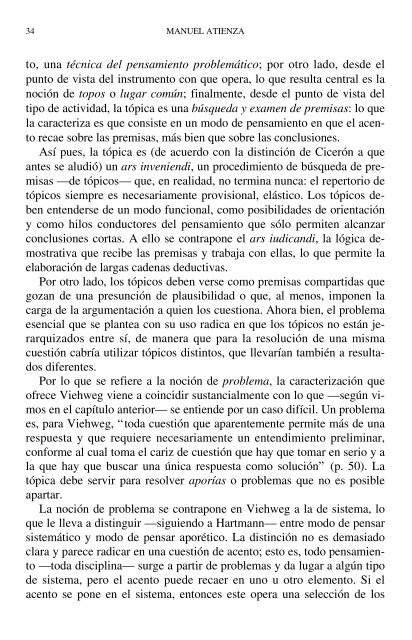LAS RAZONES DEL DERECHO Teo rías de la ar gu men ta ción ju rí di ca
Create successful ePaper yourself
Turn your PDF publications into a flip-book with our unique Google optimized e-Paper software.
34 MANUEL ATIENZA<br />
to, una técni<strong>ca</strong> <strong>de</strong>l pensamiento problemático; por otro <strong>la</strong>do, <strong>de</strong>s<strong>de</strong> el<br />
punto <strong>de</strong> vis<strong>ta</strong> <strong>de</strong>l instru<strong>men</strong>to con que opera, lo que resul<strong>ta</strong> central es <strong>la</strong><br />
no<strong>ción</strong> <strong>de</strong> topos o lug<strong>ar</strong> común; final<strong>men</strong>te, <strong>de</strong>s<strong>de</strong> el punto <strong>de</strong> vis<strong>ta</strong> <strong>de</strong>l<br />
tipo <strong>de</strong> actividad, <strong>la</strong> tópi<strong>ca</strong> es una búsqueda y exa<strong>men</strong> <strong>de</strong> premisas: lo que<br />
<strong>la</strong> c<strong>ar</strong>acteriza es que consiste en un modo <strong>de</strong> pensamiento en que el acento<br />
re<strong>ca</strong>e sobre <strong>la</strong>s premisas, más bien que sobre <strong>la</strong>s conclusiones.<br />
Así pues, <strong>la</strong> tópi<strong>ca</strong> es (<strong>de</strong> acuerdo con <strong>la</strong> <strong>di</strong>stin<strong>ción</strong> <strong>de</strong> Cicerón a que<br />
antes se alu<strong>di</strong>ó) un <strong>ar</strong>s invenien<strong>di</strong>, un proce<strong>di</strong>miento <strong>de</strong> búsqueda <strong>de</strong> premisas<br />
—<strong>de</strong> tópicos— que, en realidad, no termina nun<strong>ca</strong>: el repertorio <strong>de</strong><br />
tópicos siempre es neces<strong>ar</strong>ia<strong>men</strong>te provisional, elástico. Los tópicos <strong>de</strong>ben<br />
enten<strong>de</strong>rse <strong>de</strong> un modo funcional, como posibilida<strong>de</strong>s <strong>de</strong> orien<strong>ta</strong><strong>ción</strong><br />
y como hilos conductores <strong>de</strong>l pensamiento que sólo permiten al<strong>ca</strong>nz<strong>ar</strong><br />
conclusiones cor<strong>ta</strong>s. A ello se contrapone el <strong>ar</strong>s iu<strong>di</strong><strong>ca</strong>n<strong>di</strong>, <strong>la</strong> lógi<strong>ca</strong> <strong>de</strong>mostrativa<br />
que recibe <strong>la</strong>s premisas y trabaja con el<strong>la</strong>s, lo que permite <strong>la</strong><br />
e<strong>la</strong>bora<strong>ción</strong> <strong>de</strong> <strong>la</strong>rgas <strong>ca</strong><strong>de</strong>nas <strong>de</strong>ductivas.<br />
Por otro <strong>la</strong>do, los tópicos <strong>de</strong>ben verse como premisas comp<strong>ar</strong>tidas que<br />
gozan <strong>de</strong> una presun<strong>ción</strong> <strong>de</strong> p<strong>la</strong>usibilidad o que, al <strong>men</strong>os, imponen <strong>la</strong><br />
c<strong>ar</strong>ga <strong>de</strong> <strong>la</strong> <strong>ar</strong><strong>gu</strong><strong>men</strong><strong>ta</strong><strong>ción</strong> a quien los cuestiona. Ahora bien, el problema<br />
esencial que se p<strong>la</strong>ntea con su uso ra<strong>di</strong><strong>ca</strong> en que los tópicos no están jer<strong>ar</strong>quizados<br />
entre sí, <strong>de</strong> manera que p<strong>ar</strong>a <strong>la</strong> resolu<strong>ción</strong> <strong>de</strong> una misma<br />
cuestión <strong>ca</strong>b<strong>rí</strong>a utiliz<strong>ar</strong> tópicos <strong>di</strong>stintos, que llev<strong>ar</strong>ían <strong>ta</strong>mbién a resul<strong>ta</strong>dos<br />
<strong>di</strong>ferentes.<br />
Por lo que se refiere a <strong>la</strong> no<strong>ción</strong> <strong>de</strong> problema, <strong>la</strong> c<strong>ar</strong>acteriza<strong>ción</strong> que<br />
ofrece Viehweg viene a coinci<strong>di</strong>r sus<strong>ta</strong>ncial<strong>men</strong>te con lo que —según vimos<br />
en el <strong>ca</strong>pítulo anterior— se entien<strong>de</strong> por un <strong>ca</strong>so <strong>di</strong>fícil. Un problema<br />
es, p<strong>ar</strong>a Viehweg, “toda cuestión que ap<strong>ar</strong>ente<strong>men</strong>te permite más <strong>de</strong> una<br />
respues<strong>ta</strong> y que requiere neces<strong>ar</strong>ia<strong>men</strong>te un enten<strong>di</strong>miento prelimin<strong>ar</strong>,<br />
conforme al cual toma el c<strong>ar</strong>iz <strong>de</strong> cuestión que hay que tom<strong>ar</strong> en serio y a<br />
<strong>la</strong> que hay que busc<strong>ar</strong> una úni<strong>ca</strong> respues<strong>ta</strong> como solu<strong>ción</strong>” (p. 50). La<br />
tópi<strong>ca</strong> <strong>de</strong>be servir p<strong>ar</strong>a resolver apo<strong><strong>rí</strong>as</strong> o problemas que no es posible<br />
ap<strong>ar</strong>t<strong>ar</strong>.<br />
La no<strong>ción</strong> <strong>de</strong> problema se contrapone en Viehweg a <strong>la</strong> <strong>de</strong> sistema, lo<br />
que le lleva a <strong>di</strong>stin<strong>gu</strong>ir —si<strong>gu</strong>iendo a H<strong>ar</strong>tmann— entre modo <strong>de</strong> pens<strong>ar</strong><br />
sistemático y modo <strong>de</strong> pens<strong>ar</strong> aporético. La <strong>di</strong>stin<strong>ción</strong> no es <strong>de</strong>masiado<br />
c<strong>la</strong>ra y p<strong>ar</strong>ece ra<strong>di</strong>c<strong>ar</strong> en una cuestión <strong>de</strong> acento; esto es, todo pensamiento<br />
—toda <strong>di</strong>sciplina— surge a p<strong>ar</strong>tir <strong>de</strong> problemas y da lug<strong>ar</strong> a algún tipo<br />
<strong>de</strong> sistema, pero el acento pue<strong>de</strong> re<strong>ca</strong>er en uno u otro ele<strong>men</strong>to. Si el<br />
acento se pone en el sistema, entonces este opera una selec<strong>ción</strong> <strong>de</strong> los



